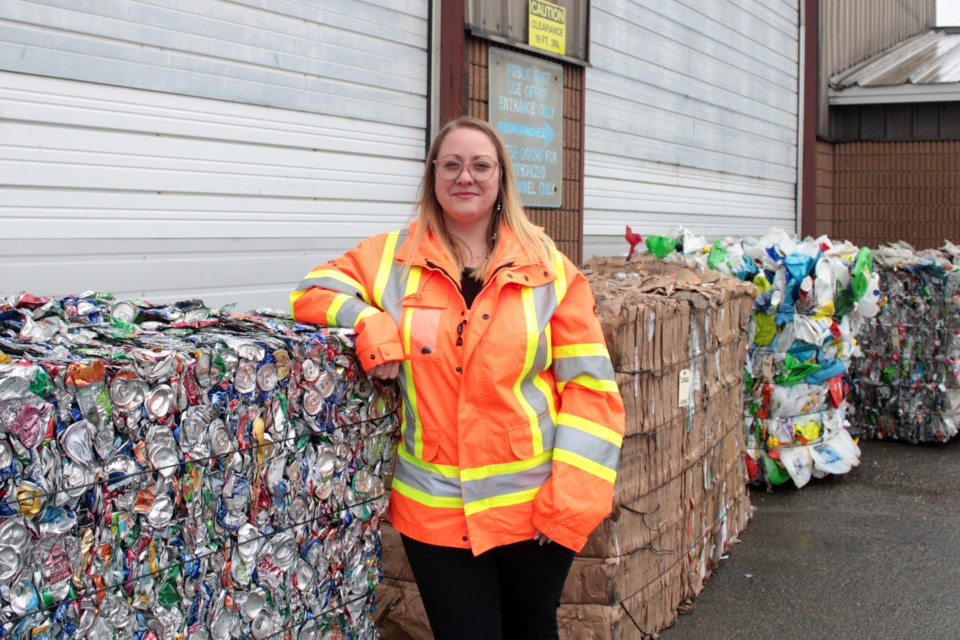Approximately 90 per cent of items placed in blue boxes in Greater Sudbury end up shipped to markets down south to be recycled.
The city would hit 100 per cent if only accepted items were placed loosely in blue boxes, with items such as tin cans cleaned of debris prior to being recycled.
City Collection and Recycling manager Nataly Wissell recently walked Sudbury.com through some of the nuances behind municipal recycling, from curbside blue boxes to the recycling markets primarily in southern Ontario.
The request for information came in response to the city’s reinvigorated push for people to divert waste from municipal landfill sites as part of the city’s Sustainable Waste Strategy.

Although the strategy includes various proposed changes to the city’s approach to waste, city council discussion has mainly centred around concerns regarding the proposed requirement that residents use clear garbage bags.
Multiple reports by municipalities to mandate the use of clear garbage bags show increased diversion from landfill sites in favour of recycling and composting. The clear bags allow municipal staff the ability to easily see within garbage bags to check for recyclable items, which can result in educational and punitive measures.
Waste diversion from landfill sites is an ongoing goal, with the city’s Community Energy and Emissions Plan calling for 90-per-cent solid waste diversion by 2050.
Last year, 91,773 tonnes of waste went to municipal landfill sites, while 4,912 tonnes of organics were processed and 16,144 tonnes of recyclables were dealt with.
“We want to keep these items out of the landfill, preserve the landfill so we can keep that running,” Wissell said.
“It’s excessively expensive to source a new landfill, and whether we’d get ministry approval to open up a new landfill is another question.”
Last year, 17,873.5 tonnes of material was placed in blue boxes, including 1,729.2 tonnes of waste which ended up at the landfill for either being ineligible or soiled (such as a tin can that hasn’t been rinsed out).
The city’s Waste Wise app allows people to search for specific items, with the same search ability available on the city’s website (click on “Wizard” to search for items). Search results include tips on what to do with each item.
The full list of items accepted in municipal blue boxes is:
- Aseptic and polycoat containers (juice boxes/milk cartons). Rinse and remove straws.
- Cardboard and boxboard (remove all plastics, flatten and cut to 30"x 30")
- Clear and coloured glass containers (no broken glass). Rinse all glass containers.
- Disposable aluminum foil, plates and trays. Rinse all items.
- Metal and cardboard food and beverage cans (tuna, juice cans). Rinse all containers.
- Paint and stain cans that are empty and dry (lids removed)
- Empty aerosol cans
- Plastic containers No. 1, 2, 4, 5 and 6. (No. 3 and 7 plastics and plastics without numbers are not recyclable). Rinse all containers.
- Rigid foam packaging (no foam peanuts or flex foam)
- Non-treated paper bags/gift bags (remove strings/hard plastic handles)
- Plastic stretch bags (no zippers and remove paper receipts).
- Paper, books, magazines
Among the most commonly misplaced items are second-use plastics, such as lawn chairs. The city only accepts single-use plastic items, such as beverage containers, in blue boxes.
The Recycling Centre includes labour-intensive manual sorting along conveyor belts, which don’t allow much room for additional manual work such as cleaning cans and opening bags.
As such, recyclables should be placed loosely in blue boxes (the only exceptions being shredded paper and rigid foam packaging), and rinsed of debris when applicable. The manual processing is also why it’s particularly problematic when people drop waste such as used diapers into blue boxes, Wissell added.
Of accepted recyclables, the following tonnages were recorded last year:
- Aluminum: 211.85
- Cardboard: 5,073.56
- Film Plastic: 76.64
- Glass: 1,966.21
- High-density polyethylene (plastic used for milk jugs, shampoo bottles): 195.12
- Mixed Paper #6: 6,880.39
- Mixed Plastics: 238.28
- Shredded Papers: 498.75
- Polyethylene terephthalate (plastic used for pop bottles): 499.70
- Polycoat Cartons (Tetra Pak containers used for beverages): 82.71
- Steel: 421.12
The city compresses these materials into dense cubes and sells them to the open marketplace.
“There are a couple of markets in Quebec and two or three markets in the U.S., but primarily the material’s staying in Ontario,” Wissell said.
Plastics are recycled into lawn furniture, strapping and clothing fibres, cardboard is turned into spiral paper products and other packaging, glass is turned into fibreglass and polystyrene foam is broken down and condensed into crown molding and other products.
Paper is turned into tissue products, and aluminum and steel is more malleable, and used in various new aluminum and steel products.
Sudbury.com sought to round out a more in-depth report on what becomes of recyclables that leave Greater Sudbury, but none of the companies the city deals with responded to our inquiry.
Tyler Clarke covers city hall and political affairs for Sudbury.com.



